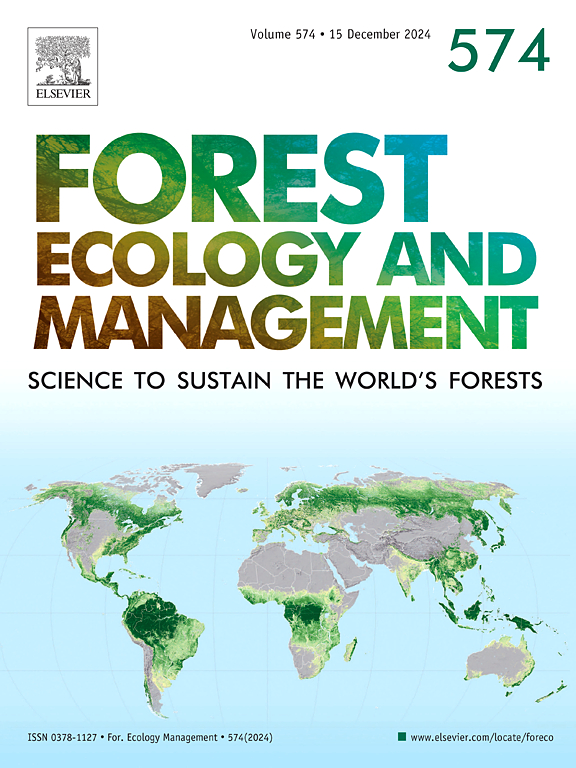Degradation of tree plantations increases soil erosion risk through changes in aggregate stability and vegetation traits
IF 3.7
2区 农林科学
Q1 FORESTRY
引用次数: 0
Abstract
Inappropriate afforestation combined with frequent extreme events has led to degradation of tree plantations globally, which may increase the risk of soil erosion. In this study we evaluated the impact of tree plantation degradation on soil erodibility. To this end, we conducted a study at three sites (Baotaqu, Zichang, and Mizhi) distributed in the semiarid Loess Plateau of China, where the dominant tree species was black locust (Robinia pseudoacacia L.). We evaluated the degrees of degradation of tree plantations by standing dead trees index and set three different levels: T1 level (Standing dead trees index = 9 n ha−1), T2 level (Standing dead trees index = 92 n ha−1), and T3 level (Standing dead trees index = 272 n ha−1). Here, we examined the changes in soil aggregate stability and erodibility index (K factor) under varying degrees of degradation of tree plantations. The results showed that the increase in degradation intensity led to a reduction in the mean weight diameter and geometric mean diameter, along with an increase in the K factor. Soil properties and vegetation traits were strong drivers of soil aggregate stability and the K factor, with soil organic carbon content having the highest explanatory power, accounting for 49.5 % of the variance. The degradation of tree plantations weakened both vegetation traits (σ = −0.45) and soil characteristics (σ = −0.73). This degradation indirectly controls the extent of soil susceptibility to erosion (R2 = 0.93). This study provides insights into the assessment of soil erosion risk related to the degradation of tree plantations, which would be further aggravated by ongoing and future climate change.
人工林的退化通过改变团聚体稳定性和植被特征增加了土壤侵蚀风险
不适当的造林加上频繁的极端事件导致全球人工林退化,这可能增加土壤侵蚀的风险。在本研究中,我们评估了人工林退化对土壤可蚀性的影响。为此,我们在中国黄土高原半干旱地区以刺槐(Robinia pseudoacacia L.)为优势树种的保塔区、紫昌和米脂3个站点进行了研究。利用枯死树指数评价人工林退化程度,设置了T1级(枯死树指数= 9 n ha−1)、T2级(枯死树指数= 92 n ha−1)和T3级(枯死树指数= 272 n ha−1)。研究了人工林不同退化程度下土壤团聚体稳定性和可蚀性指数(K因子)的变化。结果表明:随着降解强度的增大,平均重量直径和几何平均直径减小,K因子增大;土壤性质和植被性状是土壤团聚体稳定性和K因子的重要驱动因子,其中土壤有机碳含量的解释力最高,占方差的49.5 %。人工林退化使植被特征(σ = - 0.45)和土壤特征(σ = - 0.73)减弱。这种退化间接控制了土壤对侵蚀的敏感性程度(R2 = 0.93)。该研究为评估与人工林退化相关的土壤侵蚀风险提供了见解,这些风险将因持续和未来的气候变化而进一步加剧。
本文章由计算机程序翻译,如有差异,请以英文原文为准。
求助全文
约1分钟内获得全文
求助全文
来源期刊

Forest Ecology and Management
农林科学-林学
CiteScore
7.50
自引率
10.80%
发文量
665
审稿时长
39 days
期刊介绍:
Forest Ecology and Management publishes scientific articles linking forest ecology with forest management, focusing on the application of biological, ecological and social knowledge to the management and conservation of plantations and natural forests. The scope of the journal includes all forest ecosystems of the world.
A peer-review process ensures the quality and international interest of the manuscripts accepted for publication. The journal encourages communication between scientists in disparate fields who share a common interest in ecology and forest management, bridging the gap between research workers and forest managers.
We encourage submission of papers that will have the strongest interest and value to the Journal''s international readership. Some key features of papers with strong interest include:
1. Clear connections between the ecology and management of forests;
2. Novel ideas or approaches to important challenges in forest ecology and management;
3. Studies that address a population of interest beyond the scale of single research sites, Three key points in the design of forest experiments, Forest Ecology and Management 255 (2008) 2022-2023);
4. Review Articles on timely, important topics. Authors are welcome to contact one of the editors to discuss the suitability of a potential review manuscript.
The Journal encourages proposals for special issues examining important areas of forest ecology and management. Potential guest editors should contact any of the Editors to begin discussions about topics, potential papers, and other details.
 求助内容:
求助内容: 应助结果提醒方式:
应助结果提醒方式:


